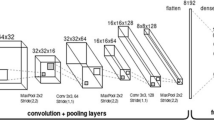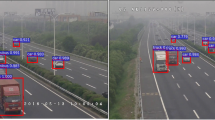Abstract
Object detection is an essential technology in the computer vision domain and plays a vital role in intelligent transportation. Intelligent vehicles utilize object detection on images for environment perception. This work develops a target detection algorithm based on deep learning technologies, particularly convolutional neural networks and neural network modeling. Building on the analysis of the traditional Haar-like vehicle recognition algorithm, a vehicle recognition algorithm based on a convolutional neural network with fused edge features (FE-CNN) is proposed. The experimental results demonstrate that FE-CNN improves the recognition precision and the model’s convergence speed through a simple and effective edge feature fusion method. In the experiment conducted using real traffic scene for vehicle recognition, the developed algorithm achieves a 99.82% recognition rate in efficient time, demonstrating the capability for real-time performance and accurate target detection.









Similar content being viewed by others
References
Li H, Wang X (2017) Vehicle feature recognition method based on deep neural network. J Henan Inst Eng (Nat Sci Ed) 29(04):44–48
Shi J (2017) Research on vehicle identification based on neural network algorithm. Comput Dig Eng 45(12):2336–2340
Yang W, Gong J, Wei L (2016) Front vehicle image recognition based on multi feature information. J Chang’ an Univ (Nat Sci Ed) 36(04):79–85
Belmiloud D, Benkedjouh T, Lachi M, Laggoun A, Dron JP (2018) Deep convolutional neural networks for Bearings failure prediction and temperature correlation. J Vibroeng 20:1–14. https://doi.org/10.21595/jve.2018.19637
Li N, Zhilei W, Zhou Fu LP (2018) Vehicle recognition technology based on computer vision. Autom Pract Technol 24:39–40
Wang S (2017) Research on vehicle information recognition technology based on neural network learning. Nanjing University of Posts and Telecommunications
Yang Z, Kuang N, Fan L, Kang B (2018) Overview of image classification algorithm based on convolutional neural network. Signal Process 34(12):1474–1489
Geng Q (2016) Research on key technologies of intelligent transportation system based on image recognition theory. Jilin University
Cai W (2018) Research on high speed vehicle detection based on convolutional neural network. Nanjing University of Posts and Telecommunications
Liu X, Sun H, Ma C, Jiang L (2019) Vehicle recognition model based on convolutional neural network multi feature combination. Comput Sci 46(S1):254–258
Boram PARK (2018) Authorship attribution in Huayan texts by machine learning using N-gram and SVM. Int J Budd Thought Cult 28(2):122–126
Ye DC et al (2013) A novel and better fitness evaluation for rough set based minimum; attribute reduction problem. Inf Sci 222(3):413–423
Xia Y, Leung H (2014) Performance analysis of statistical optimal data fusion algorithms. Inf Sci 277:808–824
Guo W, Chen G (2015) Human action recognition via multi-task learning base on spatial–temporal feature. Inf Sci 320:418–428
Guo K, Guo W, Chen Y et al (2015) Community discovery by propagating local and global information based on the MapReduce model. Inf Sci 323:73–93
Yang LH, Wang YM, Su Q et al (2016) Multi-attribute search framework for optimizing extended belief rule-based systems. Inf Sci 370:159–183
Cheng H, Su Z, Xiong N et al (2016) Energy-efficient node scheduling algorithms for wireless sensor networks using Markov Random Field model. Inf Sci 329:461–477
Wang J, Zhang X M, Lin Y et al (2018) Event-triggered dissipative control for networked stochastic systems under non-uniform sampling. Inf Sci S0020025518301749
Xia Y, Chen T, Shan J (2014) A novel iterative method for computing generalized inverse. Neural Comput 26(2):449–465
Zhong S, Chen T, He F et al (2014) Fast Gaussian kernel learning for classification tasks based on specially structured global optimization. Neural Netw 57:51–62
Zhang S, Xia Y, Wang J (2015) A complex-valued projection neural network for constrained optimization of real functions in complex variables. IEEE Trans Neural Netw Learn Syst 26(12):3227–3238
Xia Y, Wang J (2015) Low-dimensional recurrent neural network-based Kalman filter for speech enhancement. Neural Netw 67:131–139
Zhang S, Xia Y, Zheng W (2015) A complex-valued neural dynamical optimization approach and its stability analysis. Neural Netw 61:59–67
Liu G, Huang X, Guo W et al (2015) Multilayer obstacle-avoiding x-architecture steiner minimal tree construction based on particle swarm optimization. IEEE Trans Cybern 45(5):989–1002
Xia Y, Wang J (2016) A bi-projection neural network for solving constrained quadratic optimization problems. IEEE Trans Neural Netw Learn Syst 27(2):214–224
Zhang S, Xia Y (2016) Two fast complex-valued algorithms for solving complex quadratic programming problems. IEEE Trans Cybern 46(12):2837–2847
Huang Z, Yu Y, Gu J et al (2017) An efficient method for traffic sign recognition based on extreme learning machine. IEEE Trans Cybern 47(4):920–933
Kun G, Qishan Z (2013) Fast clustering-based anonymization approaches with time constraints for data streams. Knowl Based Syst 46:95–108
Chen X, Jian C (2014) Gene expression data clustering based on graph regularized subspace segmentation. Neurocomputing 143:44–50
Genggeng L, Zhisheng C, Zhen Z, Wenzhong G, Guolong C (2020) A unified algorithm based on HTS and self-adapting PSO for the construction of octagonal and rectilinear SMT. Soft Comput 24(6):3943–3961. https://doi.org/10.1007/s00500-019-04165-2
Genggeng L, Xing H, Wenzhong G, Yuzhen N, Guolong C (2015) Multilayer obstacle-avoiding X-architecture Steiner minimal tree construction based on particle swarm optimization. IEEE Trans Cybern 45(5):989–1002. https://doi.org/10.1109/TCYB.2014.2342713
Genggeng L, Wenzhong G, Yuzhen N, Guolong C, Xing H (2015) A PSO-based-timing-driven Octilinear Steiner Tree Algorithm for VLSI routing considering bend reduction. Soft Comput 19(5):1153–1169. https://doi.org/10.1007/s00500-014-1329-2
Genggeng L, Wenzhong G, Rongrong L, Yuzhen N, Guolong C (2015) XGRouter: high-quality global router in X-architecture with particle swarm optimization. Front Comput Sci 9(4):576–594
Guo W, Liu G, Chen G, Peng S (2014) A hybrid multi- objective PSO algorithm with local search strategy for VLSI partitioning. Front Comput Sci 8(2):203–216. https://doi.org/10.1007/s11704-014-3008-y
Xing H, Genggeng L, Wenzhong G, Yuzhen N, Guolong C (2015) Obstacle-avoiding algorithm in X-architecture based on discrete particle swarm optimization for VLSI design. ACM Trans Des Autom Electron Syst 20(2):28. https://doi.org/10.1145/2742143 ((Article 24))
Xing H, Wenzhong G, Genggeng L, Guolong C (2016) FH-OAOS: a fast 4-step heuristic for obstacle-avoiding octilinear architecture router construction. ACM Trans Des Autom Electron Syst 21(3):30. https://doi.org/10.1145/2856033 ((Article 48))
Xing H, Wenzhong G, Genggeng L, Guolong C (2017) MLXR: multi-layer obstacle-avoiding X-architecture Steiner tree construction for VLSI routing. Sci China Inf Sci 60(1):1–3
ImageNet Image Database [DB/OL]. http://www.image-net.org/download
Acknowledgements
This work is supported by Department of Education of Guangdong Province Project (GKY-2019CQYJ-5) and (GKY-2020KYZDK-7) and GDAS' Project of Science and Technology Development (nos. 2020GDASYL-20200402007 and 2018GDASCX-0115). The authors extend their appreciation to the Deanship of Scientific Research at King Saud University for funding this work through Research Group No. RG-1441-331.
Author information
Authors and Affiliations
Corresponding author
Additional information
Publisher's Note
Springer Nature remains neutral with regard to jurisdictional claims in published maps and institutional affiliations.
Rights and permissions
About this article
Cite this article
Qiu, L., Zhang, D., Tian, Y. et al. Deep learning-based algorithm for vehicle detection in intelligent transportation systems. J Supercomput 77, 11083–11098 (2021). https://doi.org/10.1007/s11227-021-03712-9
Accepted:
Published:
Issue Date:
DOI: https://doi.org/10.1007/s11227-021-03712-9




